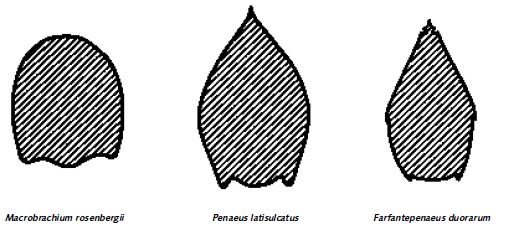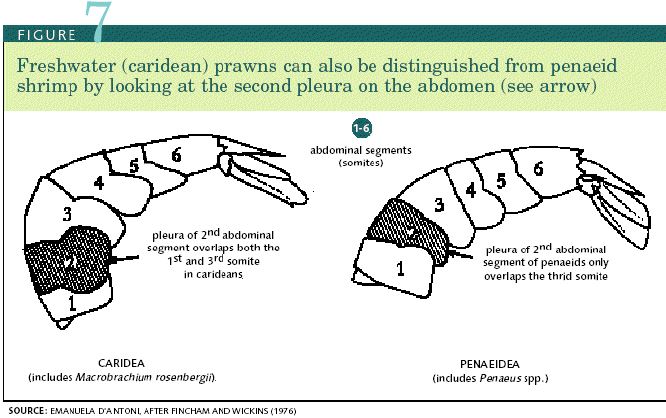1.3 Life history
All freshwater prawns (like other crustaceans) have to regularly cast their ‘exoskeleton’ or shell in order to grow. This process is referred to as moulting and is accompanied by a sud-
FIGURE6
The body shape of freshwater prawns (Macrobrachium rosenbergii) is different to that of penaeid shrimp, as these cross sections of the 5th abdominal segments show

SOURCE: EMANUELA D’ANTONI, AFTER FINCHAM AND WICKINS (1976)

den increase in size and weight. There are four distinct phases in the life cycle of the freshwater prawn, namely eggs, larvae, postlarvae (PL) and adults. The time spent by each species of Macrobrachium in the different phases of its life cycle (and its growth rate and maximum size) varies, not only specifically but according to environmental conditions, mainly temperature.
The life cycle of M. rosenbergii can be summarized as follows. The mating (copulation) of adults results in the deposition of a gelatinous mass of semen (referred to as a spermatophore) on the underside of the thoracic region of the female’s body (between the walking legs). Successful mating can only take place between ripe females, which have just completed their pre-mating moult (usually at night) and are therefore soft-shelled, and hardshelled males. All of the various types of males are capable of fertilising females but their behaviour is different (see Annex 8). Detailed descriptions of the mating process are given in Ismael and New (2000) and Karplus, Malecha and Sagi (2000). Under natural conditions, mating occurs throughout the year, although there are sometimes peaks of activity related to environmental conditions. In tropical areas these coincide with the onset of the rainy season, whereas in temperate areas they occur in the summer.
Within a few hours of copulation, eggs are extruded through the gonopores and guided by the ovipositing setae (stiff hairs), which are at the base of the walking legs, into the brood chamber. During this process the eggs are fertilized by the semen attached to the exterior of the female’s body. The eggs are held in the brood chamber (stuck to the ovigerous setae) and kept aerated by vigorous movements of the swimmerets. This is in contrast to penaeid shrimp, whose fertilized eggs are released into the sea, where they hatch. The length of time that the eggs are carried by female freshwater prawns varies but is not normally longer than three weeks. The number of eggs which are laid depends also on the size of the female. Female prawns of M. rosenbergii are reported to lay from 80 000 to 100 000 eggs during one spawning when fully mature. However, their first broods, (i.e. those which are produced within their first year of life), are often not more than 5 000 to 20 000.
Females normally become mature when they reach 15-20 g but berried females have been observed as small as 6.5 g (Daniels, Cavalli and Smullen 2000). Under laboratory conditions, where a breeding stock of both males and females was kept, it has been noted that egg incubation time averaged 20 days at 28°C (range 18-23 days). Ovaries frequently ripened again while females were carrying eggs. Pre-mate intermoults were separated by as little as 23 days (i.e. females on some occasions hatched two batches of eggs within a one-month period). It is unlikely that this would happen under natural conditions but it does show the potential fecundity of the animal.
As the eggs hatch, a process which is normally completed for the whole brood within one or two nights, the larvae (free-swimming zoeae) are dispersed by rapid movements of the abdominal appendages of the parent. Freshwater prawn larvae are planktonic and swim actively tail first, ventral side uppermost (i.e. upside down). M. rosenbergii larvae require brackishwater for survival. Those which hatch in freshwater will die unless they reach brackishwater within a few days. There are a number of microscopically distinct stages during the larval life of freshwater prawns, which lasts several weeks (Annex 1).
Individual larvae of M. rosenbergii have been observed, in hatchery conditions, to complete their larval life in as little as 16 days but reaching this stage may take much longer, depending on water temperature and other factors. The importance of this observation is fully discussed later in the manual. Larvae eat continuously and, in nature, their diet is principally zooplankton (mainly minute crustaceans), very small worms, and the larval stages of other aquatic invertebrates.
On completion of their larval life, freshwater prawns metamorphose into postlarvae (PL). From this point onwards they resemble miniature adult prawns and become mainly crawling rather than free-swimming animals. When they do swim it is usually in a normal (dorsal side uppermost) way and in a forward direction. Rapid evasive movement is also achieved by contracting the abdominal muscles and rapid movement of the tail fan.
Postlarvae exhibit good tolerance to a wide range of salinities, which is a characteristic of freshwater prawns.
Postlarvae begin to migrate upstream into freshwater conditions within one or two weeks after metamorphosis and are soon able to swim against rapidly flowing currents and to crawl over the stones at the shallow edges of rivers and in rapids. They can climb vertical surfaces and cross land, provided there is abundant moisture available. In addition to using the foods available to them as larvae, they now utilize larger pieces of organic material, both of animal and vegetable origin. Postlarval freshwater prawns are omnivorous and, as they grow, their natural diet eventually includes aquatic insects and their larvae, algae, nuts, grain, seeds, fruits, small molluscs and crustaceans, fish flesh and the offal of fish and other animals. They can also be cannibalistic. Further reading on this topic may be found in Ling (1969).